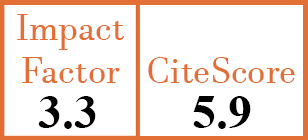Full Papers
Research trends of the aetiology of systemic lupus erythematosus in the past 10 years: a bibliometric analysis (2014-2023)
Y.-L. Yan1, Y.-S. Su2, J.-J. Cao3, J. Lin4, J.-L. Sun5, C.-F. Zhang6, R.-D. Su7
- Departments of Rheumatology, Xiang'an Hospital of Xiamen University, Xiamen, China. 749612239@qq.com
- Department of Rheumatology, Hebei General Hospital, Shijiazhuang, China.
- Department of Rheumatology, Hebei General Hospital, Shijiazhuang, China.
- Department of Medical Cosmetology, Hebei General Hospital, Shijiazhuang, China.
- Department of Respiratory and Critical Care, Jimsar County General Hospital, Changji, China.
- Department of Dermatology, Jimsar County General Hospital, Changji, China.
- Department of Aristogenesis Clinic, Women and Children’s Hospital, School of Medicine, Xiamen University, Xiamen, China.
CER18687
2025 Vol.43, N°9
PI 1650, PF 1660
Full Papers
PMID: 40314992 [PubMed]
Received: 05/03/2025
Accepted : 14/04/2025
In Press: 01/05/2025
Published: 18/09/2025
Abstract
OBJECTIVES:
Systemic lupus erythematosus (SLE) is a chronic autoimmune disease characterised by a complex aetiology that encompasses genetic, environmental, and immunological factors. A comprehensive understanding of SLE aetiology is essential for the development of effective therapeutic strategies and the enhancement of patient outcomes. This study aims to provide a thorough bibliometric analysis of research concerning the aetiology of SLE conducted over the past decade.
METHODS:
A bibliometric analysis was conducted based on articles published between January 2014 and December 2023, retrieved from the Web of Science Core Collection database. The analysis employed the R package ‘bibliometrix’, as well as VOSviewer and CiteSpace.
RESULTS:
A total of 5,825 publications were analysed. The results underscore the global collaborative nature of SLE research, with significant contributions from China, the USA, and Japan. Notable institutions included Harvard University, the Chinese Academy of Medical Sciences, and the Egyptian Knowledge Bank. Influential journals in the field comprised Arthritis & Rheumatology, Annals of the Rheumatic Diseases, and Frontiers in Immunology. Key word analysis revealed a recent emphasis on terms such as ‘management’,’efficacy’, and ‘safety’, together with emerging interests in ‘health’ and ‘genes’.
CONCLUSIONS:
This study provides a bibliometric analysis of SLE aetiology research, highlighting evolving research trends, influential studies, and collaborative networks. The findings indicate a shift in research focus from specific disease pathogenesis and expression toward genetic mechanisms, diagnostic approaches, and clinical applications. Future research on SLE aetiology is likely to prioritise investigations into DNA, genes, and validating existing findings.


